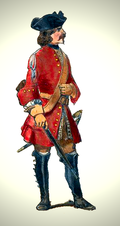- Mounted infantry
-
Mounted infantry were soldiers who rode horses instead of marching, but actually fought on foot (in the modern era with muskets or rifles, but before that with spears, bows, or crossbows). The original dragoons were essentially mounted infantry. According to the 1911 Encyclopædia Britannica, "Mounted rifles are half cavalry, mounted infantry merely specially mobile infantry."
Contents
Pre-gunpowder
The origins of mounted infantry go back to at least the beginnings of organised warfare. With the weight ancient bronze armour national champions would travel to battle on chariots before dismounting to fight. With the evolution of hoplite warfare, some hoplites would travel to battle on horseback, before again dismounting to take their place in the phalanx. Early pre-Marian Roman military had units consisting of mounted infantry with units clinging to the saddles of the cavalry to take them to battle and then dismounting to fight. The Han Dynasty also extensively used mounted infantry in their campaigns against the Xiongnu Confederation. During many of the Han campaigns, the vast majority of the army rode on horseback; either as mounted cavalry or mounted infantry who fought dismounted.
Other notable infantry to use the horse to enhance their mobility include the Genoese crossbowmen, and Viking raiders who would gather all the horses they could find in the vicinity of their landings.
Dragoons
 A French dragoon (c.1700).
A French dragoon (c.1700).
Dragoons originally were mounted infantry, who were trained in horse riding as well as infantry fighting skills. However, usage altered over time and during the 18th century, dragoons evolved into conventional light cavalry units and personnel. Dragoon regiments were established in most European armies during the late 17th century and early 18th century.
The name is possibly derived from a type of firearm (called a dragon) carried by dragoons of the French Army. There is no distinction between the words dragon and dragoon in French.
The title has been retained in modern times by a number of armoured or ceremonial mounted regiments.
19th century
With the invention of accurate and quick firing repeating rifles in the middle of the 19th century, cavalry started to become increasingly vulnerable. Many armies started to use troops which could either fight on horseback or on foot as circumstances dictated. Fighting on horseback with swords or lances would allow rapid movement without cover from enemy fire, whilst fighting on foot with rifles allowed them to make use of cover and to form defensive lines.
The distinction between cavalry and mounted infantry was in practice somewhat vague, but the mid-19th century onwards some cavalry units in the American Civil War, the Boers in the First and Second Boer Wars and others usually fought as mounted infantry. The first mounted infantry units to be named as such were raised during the Mexican-American War (as the Regiment of Mounted Riflemen, but redesignated Third Cavalry Regiment in 1861) and others followed, for example in Australia in the 1880s. Terms such as "mounted rifles" were often used. The French Foreign Legion used mule-mounted companies from the 1880s. Each mule was shared by two legionnaires, who took turns riding it. This arrangement allowed for faster and more prolonged marches that could cover 60 miles in one day.
In the British Army, infantry units in some parts of the British Empire had a mounted platoon for scouting and skirmishing. In addition, many locally raised units such as the Ceylon Mounted Rifles, Cape Mounted Rifles and Natal Carbineers fought as mounted infantry. In the Second Boer War, the British copied the Boers and raised large forces of their own mounted infantry. Among various ad hoc formations, the Imperial Yeomanry was raised from volunteers in Britain in 1900 and 1901.
As part of the lessons learned from that war, British regular cavalry regiments were armed with the same rifle as the infantry and became well-trained in dismounted tactics (although they never lost their obsession with the charge).
20th century transition
Many European armies also used bicycle infantry in a similar way that mounted infantry used horses. However they were handicapped by the need for proper roads.[1]
The Australian 4th Light Horse Brigade which took part in the cavalry charge in the Battle of Beersheba (1917) during World War I were regarded as a mounted infrantry brigade, while the New Zealand Mounted Rifles Brigade which also took part in this battle were mounted riflemen.
Mounted infantry largely disappeared with the demise of the horse as a means of military transport in the 1930s and 1940s. Germany deployed a few horse-mounted infantry units on the Russian Front during the Second World War, and cyclist units on both fronts as well, and both Germany and Britain (which had used cyclist battalions in the First World War) experimented with motorcycle battalions. Germany also utilized organic horse and bicycle mounted troops within infantry formations throughout World War Two, although bicycle use increased as Germany retreated into its own territory. Japan deployed cyclists to great effect in its 1941 to 1942 campaign in Malaya and drive on Singapore during World War II. A horsed cavalry regiment of the Philippine Scouts assisted in the defense of the Philippines at the onset of World War II. The 10th Mountain Division of the U.S. Army also maintained a Mounted Reconnaissance Troop throughout World War Two, which saw service in Italy and Austria during the war.
Countries with entrenched military traditions like Switzerland retained horse-mounted troops well into the Cold War, while Sweden kept much of its infantry on bicycles during the snow-free months.
Falkland Islands
After the Falklands War, due the distances involved when patrolling, some British Army infantry units were taught to ride Welsh mountain ponies.[citation needed]
See also
References and notes
- ^ Fitzpatrick, Jim (1998). The Bicycle In Wartime: An Illustrated History. Washington, DC: Brassey's Inc.. ISBN 1-57488-157-4.
External links
Categories:- Equestrianism
- Combat occupations
- Infantry
- Infantry type
Wikimedia Foundation. 2010.
